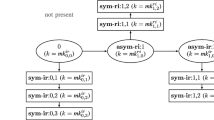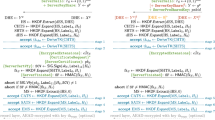Abstract
Wireless mesh networks facilitate the development of the many group oriented applications by extending the coverage area of the group communication. Group communication in a wireless mesh network is complicated due to dynamic intermediate mesh points, access control for communications between different administrative domains, and the absence of a centralized network controller. In this study, we propose a topology-matching decentralized multi-service group key management scheme for wireless mesh networks. It allows service providers to update and deliver their group keys to valid members in a distributed manner using the identity-based encryption scheme. The analysis result indicates that the proposed scheme has advantages with regard to the rekeying cost and storage overhead for a member and a mesh point in multi-sender group communication environments. The stateless property is also achieved such that a stateless member, who could not be constantly online, can easily decrypt the rekeying messages without recording the past history of transmission.







Similar content being viewed by others
Notes
Comparing to [13], this study expands the group key management to the many-to-many group communications considering stateless receivers. This study focuses on enhancing the scalability of the multi-sender group key management in wireless mesh networks using the identity-based encryption.
References
Akyildiz IF, Wang X, Wang W (2005) Wireless mesh networks: a survey. Comput Networks 47:445–487
Zhang Y, Fang Y (2007) A secure authentication and billing architecture for wireless mesh networks. Wirel Netw 13:663–678
WiMAX Forum (2006) Mobile WiMAX—Part I: A technical overview and performance evaluation
Rafaeli S, Hutchison D (2003) A survey of key management for secure group communication. ACM Comput Surv 35:309–329
Ivan A, Dodis Y (2003) Proxy cryptography revisited. In: Proceedings network and distributed system security symposium
Wong CK, Gouda MG, Lam SS (1998) Secure group communications using key graphs. In: Proceedings ACM SIGCOMM, pp 68–79
McGrew DA, Sherman AT (1998) Key establishment in large dynamic groups using one-way function trees. Tech. Rep. No. 0755, TIS Labs at Network Associates, Inc., Glenwood, Md
Pour AN, Kumekawa K, Kato T, Itoh S (2007) A hierarchical group key management scheme for secure multicast increasing efficiency of key distribution in leave operation. Comput Networks 51:4727–4743
Mittra S (1997) Iolus: a framework for scalable secure multicasting. In: Proceeding ACM SIGCOMM, pp 277–288
Steiner M, Tsudik G, Waidner M (1996) Diffie-Hellman key distribution extended to group communication. In: Proceedings ACM CCS, pp 31–37
Chiu Y, Lei C, Huang C, (2005) Secure multicast using proxy encryption. In: Proceedings international conference on information and communications security, Lecture Notes in Computer Science 3783, pp 280–290
Huang C-Y, Chiu Y-P, Chen K-T, Lei C-L (2007) Secure multicast in dynamic environments. Comput Networks 51:2805–2817
Hur J, Shin Y, Yoon H (2007) Decentralized group key management for dynamic networks using proxy cryptography. In: Proceedings the 3rd ACM international workshop on QoS and security for wireless and mobile networks
Zhang J, Varadharajan V (2006) A scalable multi-service group key management scheme. In: Proceedings advanced int’l conference on telecommunications and int’l conference on internet and web applications and services
Sun Y, Liu KJR (2007) Hierarchical group access control for secure multicast communications. IEEE/ACM Trans Netw 15:1514–1526
Naor D, Naor M, Lotspiech J (2001) Revocation and tracing schemes for stateless receivers. In: Proceedings (CRYPTO 2001), Lecture Notes in Computer Science 2139, pp 41–62
Huang D, Medhi D (2004) A key-chain based keying scheme for many-to-many secure group communication. ACM Trans Inf Syst Secur 7:1–30
Lin R, Jan J (2007) A tree-based scheme for security of many-to-many communications. J High Speed Netw 16:69–79
Boneh D, Franklin M (2001) Identity-based encryption from the weil pairing. In: Proceedings (CRYPTO 2001), Lecture Notes in Computer Science 2139, pp 213–229
Bertoni GM, Chen L, Fragneto P, Harrison KA, Pelosi G (2005) Computing tate pairings on smart cards. White Paper STMicroelectronics
Galbraith SD, Harrison K, Soldera D (2002) Implementing the tate pairing. In: Proceedings 5th international symposium on algorithmic number theory, Lecture Notes in Computer Science 2369, pp 324–337
Fujisaki E, Okamoto T (1999) Secure integration of asymmetric and symmetric encryption schemes. In: Proceedings CRYPTO, pp 537–554
Bellare M, Desai A, Pointcheval D, Rogaway P (1998) Relations among notions of security for public-key encryption schemes. In: Proceedings CRYPTO’98, pp 26–45
Green M, Ateniese G (2007) Identity-based proxy re-encryption. In: Proceedings applied cryptography and network security, Lecture Notes in Computer Science 4521, pp 288–306
Stinson, DR (2006) Cryptography theory and practice, 3rd edn. Chapman & Hall/CRC, London
Miller VS (2004) The weil pairing and its efficient calculation. J Cryptol 17:235–261
Choie YJ, Lee E (2004) Implementation of tate pairing on hyperelliptic curves of genus 2. In: Proceedings (ICISC 2003), Lecture Notes in Computer Science 2971, pp 97–111
Hwu J, Chen R, Lin Y (2006) An efficient identity-based cryptosystem for end-to-end mobile security. IEEE Trans Wirel Commun 5:2586–2593
Wang L, Wu C-K (2005) Efficient identity-based multicast scheme from bilinear pairing. IEE Proc Commun 152(6):877–882
IEEE (2001) IEEE 802.1x: IEEE standards for local and metropolitan area networks: Port based network access control
Chen L, Malone-Lee J (2005) Improved identity-based signcryption. In: Proceedings PKC, Lecture Notes in Computer Science 3386, pp 362–379
Acknowledgements
This research is supported by the Ubiquitous Computing and Network (UCN) Project, Knowledge and Economy Frontier R&D Program of the Ministry of Knowledge Economy (MKE) in Korea as a result of UCN’s subproject 09C1-T1-20S, and the Korea Science and Engineering Foundation (KOSEF) grant funded by the Korea government (MEST) (No. R01-2007-000-20865-0).
Author information
Authors and Affiliations
Corresponding author
Rights and permissions
About this article
Cite this article
Hur, J., Yoon, H. A Multi-service Group Key Management Scheme for Stateless Receivers in Wireless Mesh Networks. Mobile Netw Appl 15, 680–692 (2010). https://doi.org/10.1007/s11036-009-0191-4
Published:
Issue Date:
DOI: https://doi.org/10.1007/s11036-009-0191-4




